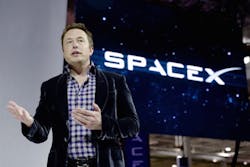Musk's SpaceX Doubles Down on Method for Cheaper Launches
Elon Musk’s rocket company is about take another step toward making space flight cheaper.
Space Exploration Technologies Corp. on Friday plans to double down on the concept of recycling spacecraft that the company has flown and landed back on Earth. In a mission for NASA, SpaceX will reuse both a rocket and a capsule that it’s fired off before.
Making space missions work more like commercial airline flights dramatically reduces costs -- less money gets wasted discarding rockets and spacecraft after single launches. SpaceX’s success in this pursuit has made it one of the world’s most richly valued private companies. It’s also won over customers including NASA, which President Donald Trump has directed to return to the moon and explore Mars with the help of private industry.
“At this point, the notion of reuse of hardware is almost unremarkable,” said Ernie Chung, an aerospace, defense and airline consultant at AlixPartners LLP. “What is remarkable is that SpaceX appears to be continuing to lead the march down the cost curve for space access.”
Trump's Directive
Trump on Monday issued a space directive that barely differs from a memo his predecessor issued in 2010, changing only a paragraph in which Barack Obama had called for NASA to send humans to an asteroid by 2025 and to orbit Mars by the mid-2030s. Trump scrapped the asteroid mission and revived ambitions to return to the moon, but set no time frame for going there or to Mars.
The White House didn’t provide details about how NASA’s moon or Mars missions would be funded. Both SpaceX and Boeing Co. have billion-dollar contracts to send American astronauts to the International Space Station, with the first key tests of the technology slated for 2018. Musk has announced plans to send paying tourists on flights around the moon next year.
In the meantime, SpaceX has been carrying out a series of unmanned missions for NASA. The company plans to ferry supplies to the space station using a pre-flown Falcon 9 rocket and a refurbished Dragon cargo capsule. The purpose of the mission, called CRS-13, will be to carry 4,800 pounds of research, crew supplies and hardware.
While parts of the Space Shuttle boosters NASA flew for decades were refurbishable, no company has pulled off the “ rapid reusability” SpaceX is targeting to bring down costs. SpaceX launched its first reused Falcon 9 rocket booster in March and reused a Dragon capsule on a space-station resupply mission in June.
Florida Comeback
CRS-13 will be the first launch in more than a year from the Florida launch pad that was significantly damaged when a Falcon 9 rocket exploded there in September 2016. SpaceX has delayed the mission twice this week to conduct additional checks, inspections and cleanings after it detected particles in one of its rocket’s fueling systems.
SpaceX spent roughly $50 million to rebuild and upgrade Space Launch Complex 40 after the accident last year, which destroyed the rocket and the satellite it was slated to carry into orbit. Work to refurbish the damaged site began in earnest in February, with upgrades including an improved water system that will allow for longer “static fires” when a SpaceX rocket’s Merlin engines are tested ahead of a launch.
The launch complex was originally built in the 1960s, John Muratore, director of the launch complex for SpaceX, told reporters during a conference call Friday.
‘Complete Rebuild’
“We found plumbing and wiring in places we didn’t expect them to be,” he said. “We saw opportunities to really improve the pad and did a complete rebuild of the entire electrical system.”
While the site at Cape Canaveral Air Force Station was out of commission, SpaceX moved its Falcon 9 launches to Pad 39A at NASA Kennedy Space Center in Florida. Now that the damaged site has been fixed, SpaceX can resume launching its smaller Falcon 9 there while readying the Kennedy Space Center pad for the maiden flight of its larger Falcon Heavy rocket, which is capable of carrying heavier payloads. SpaceX also uses a launch site at Vandenberg Air Force Base in California.
The closely held company, based in Hawthorne, Calif., has already flown 16 missions in 2017. While that’s double its number in 2016, SpaceX may fall short of a goal for at least 20 this year.
By Dana Hull
About the Author
Bloomberg
Licensed content from Bloomberg, copyright 2016.
